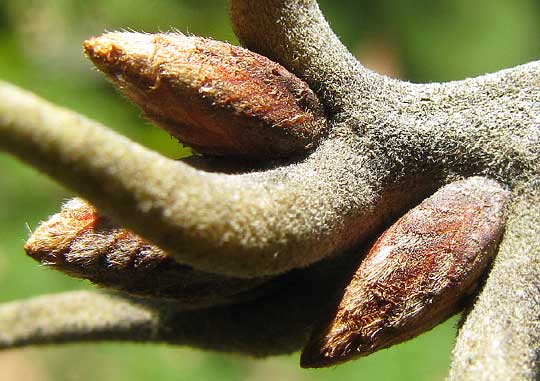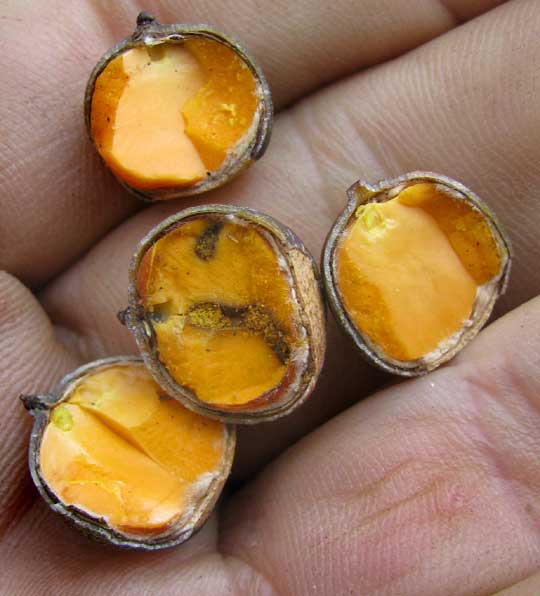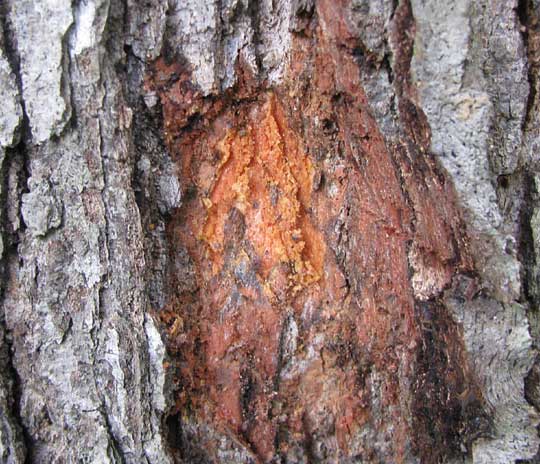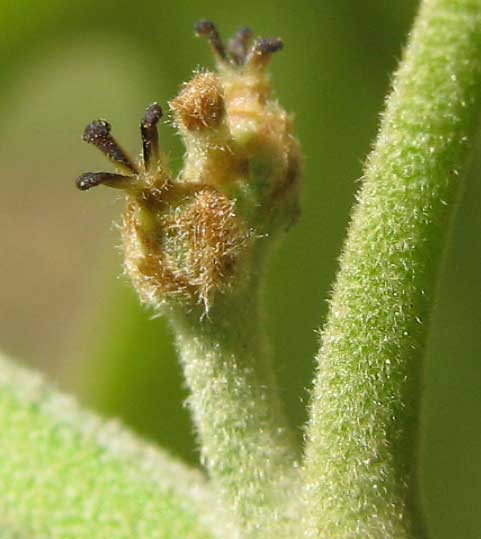Excerpts from Jim Conrad's
Naturalist Newsletter
from the October 25, 2009 Newsletter, from near Natchez, Mississippi
ADMIRING THE BLACK OAK
The local oaks are especially heavily laden with acorns this year because of the unusually rainy late summer and fall. A very common oak along upland ridges in this area is the Black Oak, QUERCUS VELUTINA, one of whose bug-eaten, deeply lobed, sharp-pointed leaves and smallish, blackish acorns are shown below:

The "velutina" in Black Oak's technical name refers to the "velvety" hairiness covering young stems and leaf undersurfaces. With a magnifying glass you can see that each hair consists of several sharp points radiating from a base. Such hairs are said to be "stellate," which means "starlike." You can see the "velutinous" covering of a Black Oak's stem tipped with two scaly, rusty buds from which leaves will emerge next year, and a larger terminal bud from which next year's stem will arise, below:

Where the entry lane passes beneath a large Black Oak here and there the ground is splotched orange. That's where cars have run over Black Oak acorns, which are bright orange inside, as you can see below:

The center acorn shows a worm tunnel. In fact, probably because of the rains, most acorns I cut across are either wormy or dead and black with fungus. The acorns' orange color is produced by tannin, which benefits the oak by making the acorns very bitter or even sickening when eaten raw. Tannin interferes with an animal's ability to metabolize protein. Some animals aren't bothered by tannin while others clearly prefer acorns from oak species containing less tannin in their acorns, such as members of the white oak group. Creatures that cache acorns, like jays and squirrels, may delay eating their acorns until groundwater has leached much of the tannin out. Indigenous Americans developed several acorn-leaching methods to make acorns more palatable.
Though Black Oaks are enormously important for the acorns they provide to wildlife, and for the excellent wood they produce, at one time they were most cherished for the tannin in their bark used by the leather tanning industry, and for the natural dyes that can be made from tannin. Being careful to not injure the tree by cutting to its cambium layer, I chipped a little outer bark from a Black Oak and exposed the orange, tannin-rich inner bark seen below:

Dye from Black Oak bark can be used to produce various earth tones -- add alum and you get a rich golden yellow, add chrome for brownish yellow, tin for lemon yellow, iron for olive brown, and more. You can read about these natural dyes in the free online Google Book that can be accessed by Goggling the keywords "dye plants and dyeing quercus velutina." The first listing on the resulting page should be the 1994 book "Dye Plants and Dyeing" by Margaret Cannon. Clicking on that link should load the page on Black Oak dyes. Paging down you should see color examples of dyes produced from Black Oak bark. The entry after "Black Oak" is for the Black Walnut and then "Blackberries," on and on. This is an excellent resource.
from the March 23, 2009 Newsletter, issued from the forest near Natchez, Mississippi; elevation ~400ft (120m), ~N31.47°, ~W91.29°:
BLACK OAK'S FUTURE ACORNS
Black Oaks, QUERCUS VELUTINA, are common here and these days show up on the landscape as big, silvery- green bouquets. The silveriness is caused by short, branched, white hairs densely mantling expanding leaves and stems. On individual Black Oaks whose yellow, dangling, wormlike clusters of male flowers, or aments, already have released their pollen and are falling off, now you can spot later-blooming female flowers, which will mature into acorns next year. You can see a Black Oak's future acorns below:

In that picture the stem, newly emerged from a twig's terminal bud, is the "floor" in the lower left corner. The thing paralleling the picture's right side is a leaf petiole, and in the image's center rise two female flowers -- the future acorns -- on a short stem, or peduncle. Atop the peduncle are three female flowers, two with their black, 3-lobed stigmas deployed, ready to receive pollen. Despite the dense fuzz investing the flowers you can barely make out blunt, brown scales surrounding the oval pistil (comprising stigma, style and ovary). Later those scales will enlarge, harden and become scales on the cup below the nut. The nut will derive from the pistil.
The fact that this particular tree's aments of male flowers already have fallen off keeps down self-pollination. Other Black Oaks in the community still bear male flowers, however -- their female flowers not yet matured -- so there's still plenty of Black-Oak pollen in the air for the female flowers in the picture.